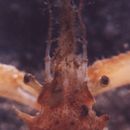Look Alikes
provided by Invertebrates of the Salish Sea
How to Distinguish from Similar Species: This is the only decorator crab with the long hooked spine behind the eye. The carapace does not have a sharp anterolateral projection as seen in Pugettia producta.
- license
- cc-by-nc-sa
- copyright
- Rosario Beach Marine Laboratory
Habitat
provided by Invertebrates of the Salish Sea
Most abundant on mixed composition bottoms
- license
- cc-by-nc-sa
- copyright
- Rosario Beach Marine Laboratory
Distribution
provided by Invertebrates of the Salish Sea
Geographical Range: Bering sea to Monterey, CA; Japan
- license
- cc-by-nc-sa
- copyright
- Rosario Beach Marine Laboratory
Habitat
provided by Invertebrates of the Salish Sea
Depth Range: Intertidal to 436 m deep
- license
- cc-by-nc-sa
- copyright
- Rosario Beach Marine Laboratory
Comprehensive Description
provided by Invertebrates of the Salish Sea
This majid crab has a heart-shaped carapace and long rostrum composed of two spinelike processes. It also has a large curved postorbital spine just behind each eye. Its legs are long and slender. It often liberally decorates itself with algae, sponges, bryozoans, or hydroids which it attaches by hooking to fine, hooked setae. Carapace length, including rostrum, up to 5 cm. Carapace color is usually brown or tan, sometimes gray. Fingers of chelipeds are white with pink or orange tips.
- license
- cc-by-nc-sa
- copyright
- Rosario Beach Marine Laboratory
Comprehensive Description
provided by Invertebrates of the Salish Sea
Biology/Natural History: This crab decorates more liberally than any of the other decorator crabs in this area. During decoration, pieces of material are attached to specialized hooked setae and also interact with pappose setae. The crab's chelae are small and delicate. In males the chelipeds are longer than the walking legs, but in females they are shorter. Will eat carrion. Predators include Pacific halibut. In Puget Sound area, eggs may be carried during most seasons. Recently hatched eggs are orange-red; eggs nearly ready to hatch are reddish-brown.
- license
- cc-by-nc-sa
- copyright
- Rosario Beach Marine Laboratory

